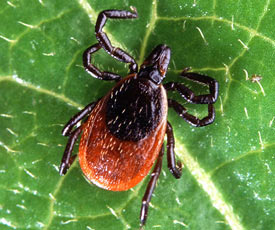A close encounter with ticks that I won't forget

Adult deer tick (Photo by Scott Bauer/Wikimedia Commons)
Anyone who knows me knows I am not a morning person, by any stretch of the imagination.
But on this particular morning, it was 8 o’clock, and I’d already stripped the bed and sofa covers, done a load of laundry, and taken a long, hot shower — all before my morning coffee.
You see, dear reader…I’d woken up, looked down at my thigh, and spotted two spots, each smaller than a poppy seed. At first, thinking they were dirt or plant material from when I’d been sitting outside the previous evening, I scratched at them. But they wouldn’t budge. Another scratch, then, dear reader…the first spot crawled.
I rushed to grab a container to place it in. Then, dislodging the other spot, I also placed it in the bin, sealed it and proceeded to watch the two spots walk around…
Ticks, dear reader. I’d already been bitten by ticks twice in my life to this point — once while paddling in Kejimikujik National Park in Nova Scotia, where we managed to dislodge it from my foot, place it in a baggie and later have it identified by a colleague as an American dog tick (i.e. not likely to carry Lyme disease). The second time, I never saw the tick but received a classic bull’s-eye bite during a visit to Waterton Park Front in Alberta, where Lyme disease is not as prevalent, but Rocky Mountain spotted fever sometimes occurs. I was given a dose of antibiotics and the bull’s-eye cleared itself up with no other symptoms.
But this time, I’d woken up in bed with ticks on my upper thigh. Which meant that they’d somehow found their way onto me the evening before — either while I was lounging in my hammock in our forested backyard, where we have seen deer wandering around, or after using my kayak, which had been lying on the grass for a few days before I used it. And they’d spent all night in our bed.
Who knew if others might be creeping around the house?
Heading to my computer, I first searched for a Land Lines blog post for tips on how to find ticks on yourself after having been outside. Checking all the locations the post metioned, I looked behind my knees. Sure enough, a third spot. Into a Tupperware my third bedmate went. Well, at least our blog post provides reliable information on where to look for ticks, I thought to myself.
Next, I Googled “How long do ticks live?”
The first answer I found sent chills down my spine: depending on the species, ticks can live up to three years. I envisioned a whole family of ticks becoming roommates with my husband and I for the next year and a half.
“How long do ticks live indoors?” I queried next.
Now THAT answer was a lot more encouraging. It turns out that ticks only last a few days indoors without a food source. So even if I didn’t manage to find each tick in that time, it was safe to say that they would eventually die on their own. I could still keep an eye out for a bull’s-eye and Lyme disease symptoms in the meantime.
“Do ticks fall off if they bite you?” followed by, “Do ticks embed themselves under skin?” I still wasn’t convinced I’d found every tick on me. The answer was encouraging: ticks eventually fall off on their own in a few days, once full. As my colleagues have reminded me, it’s obviously best to get them off as soon as possible, to reduce the risk of disease transfer.
Beyond the house now being cleaner than it had been in weeks, I had a valuable reminder that day of the importance of science literacy. I consider myself fairly science literate, most of the time. However, this experience reminded me that much of my fear had to do with popular myths I’d somehow unconsciously absorbed over the years about ticks. Had I stopped long enough to ask the right questions in my search engine and do the proper research, I’d have quickly found answers to allay my fears. It was also a good reminder that you can’t believe everything you find on the internet, and it’s best to search for sources that seem reputable, or authorities that should know what they are talking about — like Health Canada, in this case.
Which made me wonder: how many other unconscious myths have we all absorbed about nature throughout our lifetimes, which may have put species at risk? Wetlands were once drained en masse because they were considered a nuisance. Through public education, the value of wetlands as important habitat for plants and animals is now known, and they are being reclaimed. Similarly, species such as bats, snakes and spiders are often portrayed as fearsome in urban myths, often leading to a higher risk of mortality from those who don’t understand their value.
I’m not saying I’m now going to rush through a field of tall grasses without spraying myself with insect repellant, or doing a thorough tick check after the fact. But it’s a reminder that the more we know about the species and spaces around us, the more we’ll understand them. And in the case of ticks, I now know it’s possible to enjoy nature while taking the proper precautions to avoid and spot them. But if I do happen to find a tick on me after some time in nature, I’m also now better armed with knowledge of what to do next.


